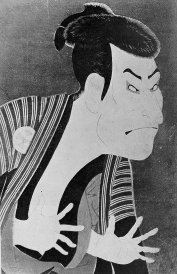
Ukiyo-e
This type of painting deals with the "floating world", meaning the world dealing with the pleasures of ordinary people. In the 17th century it was centered on painting as such, but later it developed into the art of the woodcut.
It's also another example of the growing merchant class. In order to do a ukiyo-e woodblock there was a need for four different persons. One was the person who designed the print, making a drawing and a rough indication of the colors to be used. The second person was the woodcutter who did the actual engraving. The third person was the printer and the fourth person was the actual publisher who financed the woodcuts.
Also, since the woodcuts were not terribly expensive at the time, this allowed for their spread among the "common" people.
The person who founded the ukiyo-e school was Hishikawa Moronobu (1618-1694). He was the individual most responsible from changing the ukiyo-e style from painting to woodcutting. He used subjects from the Kabuki theater and people from the entertainment district in Edo.
The paintings, actually, became so popular that it was necessary to find a way to make more of them at a reasonable price, leading to the use of woodblocks. Printing in colors started around 1740, but was limited to green and rose. By 1765 prints with a variety of colors were being produced.
The usual size of a woodblock print is about ten by fifteen inches.
The subjects of the paintings were usually actors, scenes from Kabuki drama and women. The prints of actors were extremely popular since Kabuki was popular among the less-wealthy people.
Women were shown in everyday activities (such as clipping ones toenails, below). The courtesans of the Yoshiwara district on the outskirts of Edo were also popular subjects.
In 1660, a manual of sex and "courtesan critique" was produced using ukiyo-e.
One of the great painting artists was Toshusai Sharaku who might have been a Noh actor. He made about a hundred and forty portraits of actors and managed to do that in a period of ten months.

This is an example of one of his works, a Kabuki actor.
Some more ukiyo-e prints
1: This woodblock print is from the 19th century, around the year 1900. It is titled "The Kumano Shrine", showing a scene from the Noh play Kumano. The prop the woman is riding in represents an oxen-drawn cart.
2. This is a woodblock print from around the year 1830. The print shows two Japanese courtesan's on an open veranda of a house. The courtesan standing up holds a branch decorated with money; the one sitting is reading a three-volume novel.
3. This is a woodblock print from around 1800.
4. This is a woodblock print from around 1830, "The Tengu Teaching Yoshitsune the Secret Arts of Swordmanship." A tengu is a mountain goblin. The tengu was an impish goblin, capable of changing its appearance and would sometimes appear as a Buddhist priest or nun. It would then trick monks into going down the wrong path. The tengu in this print is the konoha tengu type, characterized by its long nose.
Another belief is that tengu are reincarnated wicked Buddhist priests being punished for being too proud or too greedy. Some tengu are thought to cause people to become ill. The last Hojo regent, Hojo Takatoki (1303-1333), quite fond of drinking, was haunted by nightmares of aggressive tengu and eventually committed suicide.
This print, though, deals with Minamoto no Yoshitsune (1159-1189) who found tengu to be helpful. They taught him the secrets of martial arts and also military strategy.
When he was seven Minamoto no Yoshitsune was sent to study at a temple on Kyoto's Mounta Kurama. Tengu were said to live in the Valley of Sojo and were the ones to teach him martial arts and military strategy. Minamoto no Yoshitsune was successful with his military strategy until he was 32. He was losing a battle and ended up killing his wife and children, setting his house on fire, and committing suicide.
5. This is a print from the 1890s showing a couple children of the Meiji era.
The girls are playing a game of hagoita (a type of badminton). One of the girls has an ink drawing of bamboo, an auspicious plant at the New Year, and the other has a woodblock print of an actor.
6. This is a print from 1899 entitled "Pictures of Dancing Figures." The colors are rather well done and the way the clothes sort of billow out indicates that the figure is caught in the middle of a movement.
7. A print from around the 1830s entitled "A Mirror of beauties of the Modern Day." You can see the woman's tall get a sandals and her attractive blue kimono with its flower pattern. Maybe she knows someone from the ship and she's making her way to where the ship will dock (purely a guess on my part).
8. This is a print from around 1820 by Utagawa Kunisada (1786-1864) who lived in Edo and at fifteen became a pupil of Utagawa Toyokuni. Utagawa Kunisada specialized in prints of female figures and Kabuki actors. The courtesan in this print is clipping her toenails.
9. This is a woodblock print from the late 1860s. It's of a kabuki actor and it shows a clock on the wall; however, if you notice the clock is not exactly drawn correctly.
Main Index
Japan main page
Japanese-American Internment Camps index page
Japan and World War II index page
|